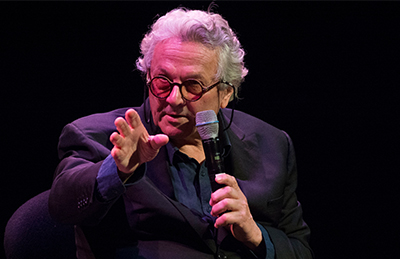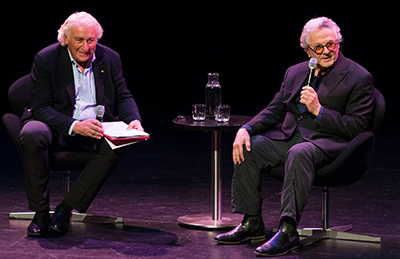Acclaimed Australian film director George Miller talked about the big and small issues in film and careers at NIDA.

Photo: George Miller on stage at NIDA’s Parade Theatre with students. (Photo: Patrick Bolan)
Acclaimed Australian film director George Miller tackled the issues big and small in film at NIDA, in an event called In Conversation.
Best known for his Mad Max franchise, with TheRoad Warrior and Fury Road being hailed as amongst the greatest immersive action films of all time, Miller is also known for his involvement in a wide range of films, including Academy Award-winners Babe and the Happy Feet film series.
Miller was up close and personal at NIDA, discussing his experience of making movies across the past 30 years, tips for young artists, what the future holds for the Australian film industry and many other issues.



Above: George Miller on stage at NIDA’s Parade Theatre with NIDA Foundation Trust Chairman Peter Ivany AM and NIDA Director/CEO Kate Cherry (Photo: Patrick Bolan)
‘NIDA was excited to welcome an artist who has changed the landscape of film, and is a major figure in the Australian industry,’ said NIDA Director/CEO Kate Cherry. ‘George is a phenomenal powerhouse and as a co-founder of the production houses Kennedy Miller Mitchell and Dr. D Studios is heavily involved in creating the movies of the future.’
Miller shared his life and industry experiences, including his early student life at UNSW studying medicine. ‘It’s hard for me to explain how I became a film maker as a simple narrative but there are key things. I was born with a twin brother but we are not identical. I spent 22 years with him in the same class and so here are two human beings with the very same life experience. We went to high school, primary school and medical school together. And I noticed how different we became through very similar experiences. I was very aware of the differences in how people think. Out of all of that I found that I had an intense curiosity about process. I was always fascinated about human beings.’
Miller talked about the difficulties in making the first Mad Max movie, released in 1979. ‘Someone said to me the great thing about being young is that you don’t know what you don’t know. It took a year to write. It took 18 months to raise money from all of our friends and family and took 10 weeks to shoot. The first editor quit after 10 days, and I spent a year cutting it in a flat in North Melbourne. Somehow I knew there was something in there to massage out of it. And then Village Roadshow agreed to release it and it became a huge success in Australia, Japan and around the world.’
‘I realised that there was something else happening for its success, it was not a coincidence that in Japan they saw it as a samurai movie, in Scandinavia they saw it as a Viking movie, and the French picked it up as a western on wheels. I had tapped into the notion of a mythological character which is the lone warrior which you see over and again, in all cinema and folklore.’
Miller also talked about what keeps him going through the difficult times of being a filmmaker, and the philosophy that underpins his practice. ‘What has kept me going was a deep and innate sense of inquiry about everything. I am always asking questions. Fundamental questions. If you do the preparation and apply intense rigor to everything that you do, then ultimately that earns your intuition the right to play. There is a direct interplay between the intellect and the intuition. And the more fuel that the intellect loads up for the intuition, the better.
‘A lot of people get by on bluster and swagger and self-confidence. But I have found that the best directors and writers and actors have an innate humility that keeps them learning, that they never ever think that they know it all. There is never a sense of mastery. They are still searching and are still curious.’
Miller was happy to take questions from students from the floor, and talked about directors he learnt the most from – silent-movie director Buster Keaton and Alfred Hitchcock – and his experiences on Babe and Happy Feet.
‘While animation is not live, you can have the advantage of moving the camera around to different angles. But it’s the same as live movies, in that it is driven by performance. Working with Robin Williams was amazing in that way,’ he said.
Miller was keen to share his experience with the NIDA students. ‘No matter how talented you are and how big your innate genius is, if you don’t drill down and work and really get all the skills under your belt, there is no way you can go out onto a stage or basketball court or football field and define the best of yourself. You might get lucky for a while. But you earn that moment. That’s what I learnt from actors Jack Nicholson and John Hargreaves and also writer Nick Enright, who I was also lucky enough to work with. He had that incredible discipline. He was a great teacher and understood the difference between preparation and execution.’
The event was chaired by NIDA Foundation Trust Chairman, Peter Ivany AM.
